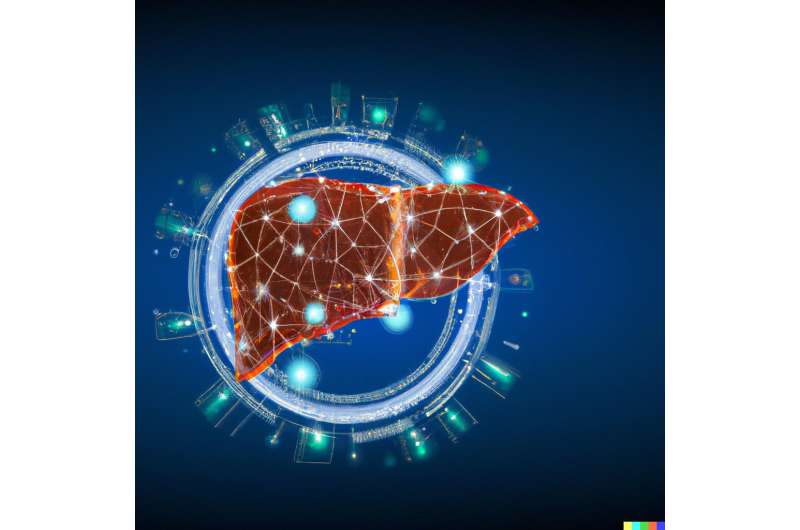
There is power and value in a highly skilled detective. Sherlock Holmes and his trusty sidekick, Watson, are famous for sifting through enormous amounts of data—identifying patterns and making predictions to uncover a mystery with ease. In the medical world, clinicians are detectives, making diagnoses and drawing conclusions based on their clinical judgment and available patient data. But just like detectives, clinicians can benefit from having a sidekick.
In a recent study at the Medical University of South Carolina (MUSC), Don Rockey, M.D., director of the Digestive Disease Research Core Center, and Jihad Obeid, M.D., a professor in Biomedical Informatics, came together to draw on an artificial intelligence (AI) approach to automate the identification of liver cirrhosis using large amounts of data from electronic health records (EHRs).
They report in the Journal of Clinical Gastroenterology that their trained convolutional neural network (CNN) model, a type of AI known as deep learning, successfully identified cirrhosis patients with a precision of 97% based on clinical text in patient discharge summaries alone.
The case
Cirrhosis, or irreversible scarring to the liver, is the final common event in patients with chronic liver disease and was ranked the 9th leading cause of death in 2021 by the Centers for Disease Control and Prevention. This complication can stem from many different forms of liver damage and disease. Historically, it has been challenging to predict which patients will progress to cirrhosis.
“We don’t know who is at risk of developing severe complications of liver disease, and identification of patients with cirrhosis is critical as we attempt to reduce morbidity and mortality from liver disease,” said Rockey.
Although there is no cure for cirrhosis, diagnosing it early would help to ensure the best management of the disease.
“If we could identify a patient predicted to have cirrhosis a year or two earlier, that would give clinicians time to treat and prevent scar tissue from accumulating in the liver but also to prevent complications of cirrhosis,” Rockey explained.
The sidekick
Like any good sidekick, AI systems can gather and analyze massive amounts of information. For a medical application, it often draws that information from the EHR, which houses the patient’s health history. Computers have long been able to “read” data that is entered into data fields or forms in the EHR.
However, computers have had a harder time accessing the information contained in narrative text, such as that found in clinician notes or discharge summaries. Earlier attempts to read this narrative text have essentially relied on keyword searches, where the keywords had to be provided by a clinician familiar with the disease, using several rounds of trial and error.
In this study, the researchers tested what could be a more able sidekick—a form of deep learning-based AI that does not need such prompts.
“The nice thing about using deep learning models is that the model learns from the examples you give it, without training it to look for certain words,” said Obeid.
The researchers trained their AI model—a convolutional neural network that mimics neurons in the brain—using medical records of patients who were diagnosed with cirrhosis. The neural network analyzed information embedded in narrative text.
“Neural networks give more power than a typical statistical AI model because each of these artificial neurons behaves like a model on its own, allowing you to come up with a more sophisticated way of distinguishing and predicting things,” Obeid stated.
Like a forensic artist adding layer after layer of traits to draft a portrait of a suspect, Obeid and Rockey’s neural network model uses many layers of artificial neurons to extract features and patterns that help to identify cirrhosis.
The potential
Once trained on records of patients with known cirrhosis established by manual chart review, Obeid and Rockey’s model was exceptionally successful at identifying patients with cirrhosis in a new set of health records based only on the narrative text in clinician notes.
“I think it’s exciting that it was successful at identifying cirrhosis using just the text in the discharge summaries, as is the idea of taking it to the next level to see if we can apply it for earlier identification,” Obeid remarked.
AI and machine learning have the potential to revolutionize the medical field, said Obeid, but it is important to emphasize that these types of models are meant not to replace but to inform clinical judgment. Clinicians will solve the case, but AI can be a powerful sidekick in helping them to do so.
“The computer is there to help clinicians, not to replace them or make decisions,” he said. “In the end, the clinicians are responsible, not the computer.”
That said, Rockey is excited about how these AI sidekicks could move medicine and, specifically, the management of liver disease forward.
“I think AI is going to be used to predict how severe the disease will become, in combination with genetics and imaging data,” said Rockey. “I don’t know how long that’s going to take to figure it out, but I can’t imagine that it’s not going to happen.”
Sarah Dooley, Medical University of South Carolina

